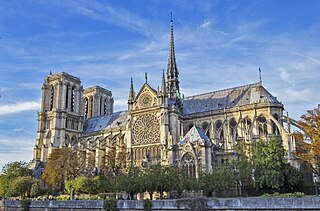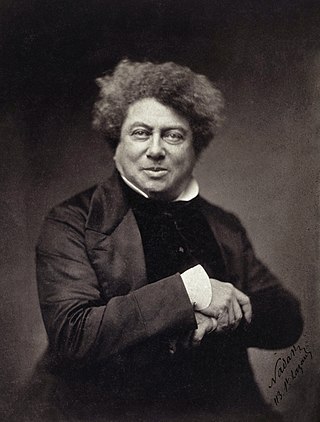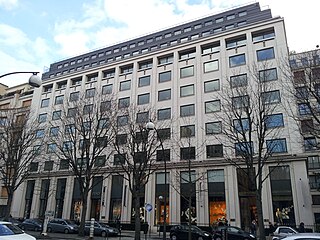
French is a Romance language of the Indo-European family. It descended from the Vulgar Latin of the Roman Empire, as did all Romance languages. French evolved from Gallo-Romance, the Latin spoken in Gaul, and more specifically in Northern Gaul. Its closest relatives are the other langues d'oïl—languages historically spoken in northern France and in southern Belgium, which French (Francien) largely supplanted. French was also influenced by native Celtic languages of Northern Roman Gaul like Gallia Belgica and by the (Germanic) Frankish language of the post-Roman Frankish invaders. Today, owing to the French colonial empire, there are numerous French-based creole languages, most notably Haitian Creole. A French-speaking person or nation may be referred to as Francophone in both English and French.

Paris is the capital and largest city of France. With an official estimated population of 2,102,650 residents in January 2023 in an area of more than 105 km2 (41 sq mi), Paris is the fourth-largest city in the European Union and the 30th most densely populated city in the world in 2022. Since the 17th century, Paris has been one of the world's major centres of finance, diplomacy, commerce, culture, fashion, and gastronomy. For its leading role in the arts and sciences, as well as its early and extensive system of street lighting, in the 19th century, it became known as the City of Light.

Ursula Kroeber Le Guin was an American author. She is best known for her works of speculative fiction, including science fiction works set in her Hainish universe, and the Earthsea fantasy series. Her work was first published in 1959, and her literary career spanned nearly sixty years, producing more than twenty novels and over a hundred short stories, in addition to poetry, literary criticism, translations, and children's books. Frequently described as an author of science fiction, Le Guin has also been called a "major voice in American Letters". Le Guin said she would prefer to be known as an "American novelist".

Victor-Marie Hugo, vicomte Hugo, sometimes nicknamed the Ocean Man, was a French Romantic writer and politician. During a literary career that spanned more than sixty years, he wrote in a variety of genres and forms.

Le Havre is a major port city in the Seine-Maritime department in the Normandy region of northern France. It is situated on the right bank of the estuary of the river Seine on the Channel southwest of the Pays de Caux, very close to the Prime Meridian. Le Havre is the most populous commune of Upper Normandy, although the total population of the greater Le Havre conurbation is smaller than that of Rouen. After Reims, it is also the second largest subprefecture in France. The name Le Havre means "the harbour" or "the port". Its inhabitants are known as Havrais or Havraises.

Notre-Dame de Paris, referred to simply as Notre-Dame, is a medieval Catholic cathedral on the Île de la Cité, in the 4th arrondissement of Paris, France. The cathedral, dedicated to the Virgin Mary, is considered one of the finest examples of French Gothic architecture. Several attributes set it apart from the earlier Romanesque style, particularly its pioneering use of the rib vault and flying buttress, its enormous and colourful rose windows, and the naturalism and abundance of its sculptural decoration. Notre-Dame also stands out for its three pipe organs and its immense church bells.
The National Rally, known as the National Front from 1972 to 2018, is a French far-right political party, described as right-wing populist and nationalist. It is the single largest parliamentary opposition party in the National Assembly since 2022. Its candidate was defeated in the second round in the 2002, 2017 and 2022 presidential elections. It opposes immigration, advocating significant cuts to legal immigration, protection of French identity, and stricter control of illegal immigration. The party advocates a "more balanced" and "independent" French foreign policy, opposing French military intervention in Africa while supporting France leaving NATO's integrated command. It also supports reform of the European Union (EU) and its related organisations as well as economic interventionism, protectionism, and zero tolerance for breaches of law and order.

Alexandre Dumas, also known as Alexandre Dumas père, was a French novelist and playwright.

Margaret LeAnn Rimes Cibrian is an American singer, songwriter and actress. She originally rose to success as a country music artist at age 13 and has since crossed over into pop, contemporary Christian, and other musical genres. Rimes has placed over 40 singles on international charts since 1996. She has sold over 48 million records worldwide, with 20.8 million album sales in the United States according to Nielsen SoundScan. Billboard ranked her at number 17 in terms of sales success in the 1990–1999 decade.

Les Misérables, colloquially known as Les Mis or Les Miz, is a sung-through musical with music by Claude-Michel Schönberg, lyrics by Alain Boublil and Jean-Marc Natel, and a book by Schönberg and Boublil, based on the 1862 novel of the same name by Victor Hugo. The original French musical premiered in Paris in 1980 with direction by Robert Hossein. Its English-language adaptation, with lyrics by Herbert Kretzmer, produced by Cameron Mackintosh, has been running in London since October 1985, making it the longest-running musical in the West End and the second longest-running musical in the world after the original Off-Broadway run of The Fantasticks. A film adaptation was released in 2012.

Matthew Steven LeBlanc is an American actor. He garnered global recognition with his portrayal of Joey Tribbiani in the NBC sitcom Friends and in its spin-off series, Joey. For his work on Friends, LeBlanc received three nominations at the Primetime Emmy Awards. He has also starred as a fictionalized version of himself in Episodes (2011–2017), for which he won a Golden Globe Award and received four additional Emmy Award nominations. He co-hosted Top Gear from 2016 to 2019. From 2016 to 2020, he played patriarch Adam Burns in the CBS sitcom Man with a Plan.

Paris Saint-Germain Football Club, commonly referred to as Paris Saint-Germain or simply PSG, is a professional football club based in Paris, France. They compete in Ligue 1, the top division of French football. As France's most successful club, they have won 50 official honours, including twelve league titles and one major European trophy. Their home ground is the Parc des Princes, located in the 16th arrondissement of Paris near the Boulogne-Billancourt commune.

Marion Anne Perrine "Marine" Le Pen is a French lawyer and politician who ran for the French presidency in 2012, 2017, and 2022. A member of the National Rally, she served as its president from 2011 to 2021. She has been the member of the National Assembly for the 11th constituency of Pas-de-Calais since 2017. She currently serves as parliamentary party leader of the National Rally in the Assembly, a position she has held since June 2022.

LVMH Moët Hennessy Louis Vuitton, commonly known as LVMH, is a French multinational holding company and conglomerate specializing in luxury goods, headquartered in Paris. The company was formed in 1987 through the merger of fashion house Louis Vuitton with Moët Hennessy, which was established following the 1971 merger between the champagne producer Moët & Chandon and the cognac producer Hennessy. In April 2023, LVMH became the first European company to surpass a valuation of $500 billion. In 2023, the company was ranked 47th in the Forbes Global 2000.

Lille Olympique Sporting Club, commonly referred to as LOSC, LOSC Lille or simply Lille, is a French professional football club based in Lille, Hauts-de-France that competes in Ligue 1, the top division of French football. Lille has played its home matches since 2012 at the Stade Pierre-Mauroy. The 50,186-capacity retractable roof venue is the fourth-largest football stadium in France.

Football Club des Girondins de Bordeaux, commonly referred to as Girondins de Bordeaux or simply Bordeaux, is a French football club based in the city of Bordeaux in Gironde, Nouvelle-Aquitaine. The team last played in Ligue 2, the second tier of French football, and was last coached by Albert Riera before giving up their status as a professional club on 25 July 2024 following years of financial mismanagement, and a failed takeover from Fenway Sports Group, the owners of Liverpool F.C. at the time.

The 24 Hours of Le Mans is an endurance-focused sports car race held annually near the town of Le Mans, France. It is widely considered to be one of the world's most prestigious races, and is one of the races—along with the Monaco Grand Prix and Indianapolis 500—that form the Triple Crown of Motorsport, and is also one of the races alongside the 24 Hours of Daytona and 12 Hours of Sebring that make up the informal Triple Crown of endurance racing. Run since 1923, it is the oldest active endurance racing event in the world.

Emmanuel Jean-Michel Frédéric Macron is a French politician who has been serving as the 25th president of France since 2017 and ex officio one of the two Co-Princes of Andorra. He previously was Minister of Economics, Industry and Digital Affairs under President François Hollande from 2014 to 2016 and Deputy Secretary-General to the President from 2012 to 2014. He has been a member of Renaissance since he founded it in 2016.

The Republicans is a liberal conservative political party in France, largely inspired by the tradition of Gaullism. The party was formed on 30 May 2015 as the re-incorporation of the Union for a Popular Movement (UMP), which had been established in 2002 under the leadership of then-President of France, Jacques Chirac.
Renaissance is a liberal and centrist political party in France. The party was originally known as En Marche ! and later La République En Marche !, before adopting its current name in September 2022. RE is the leading force of the centrist to centre-right Ensemble coalition, coalesced around Emmanuel Macron's original presidential majority.


















